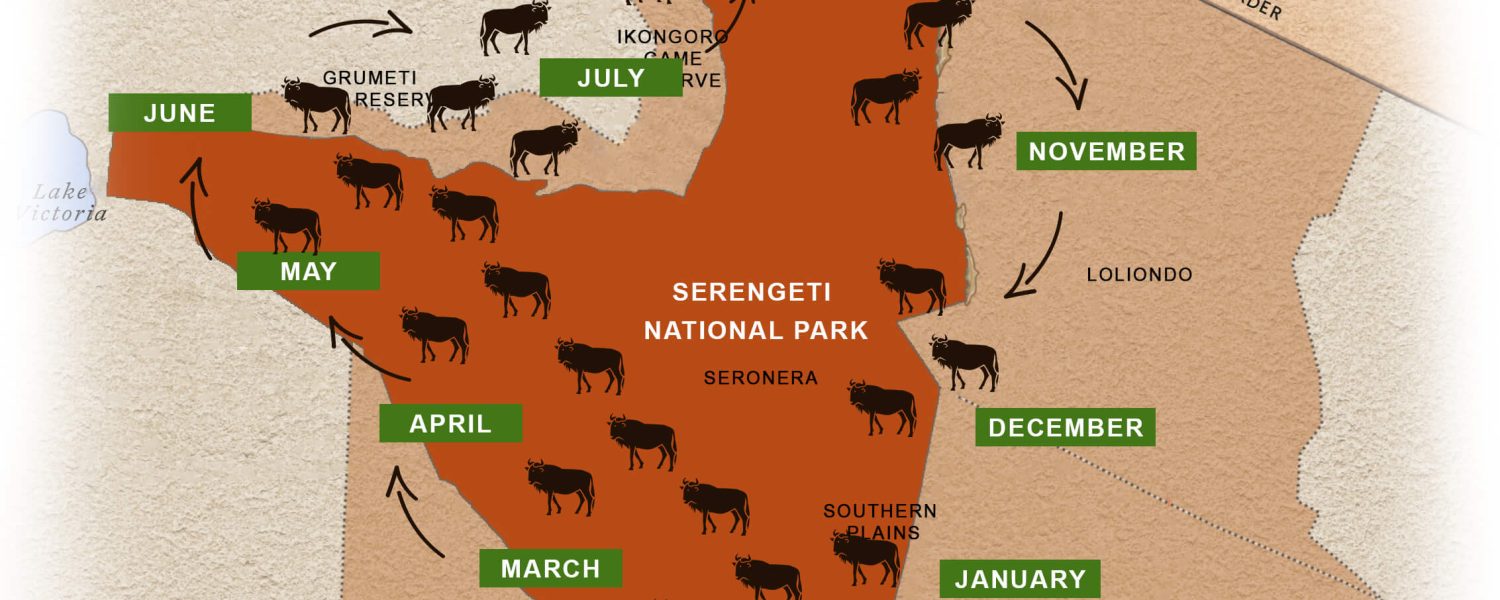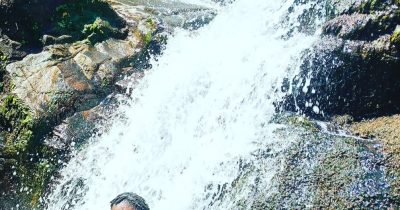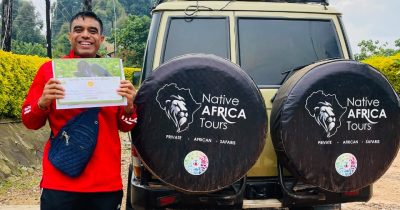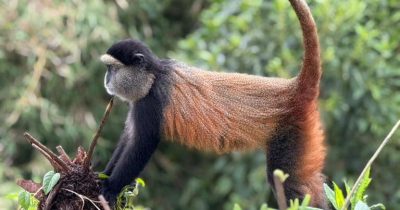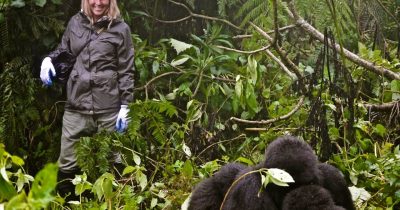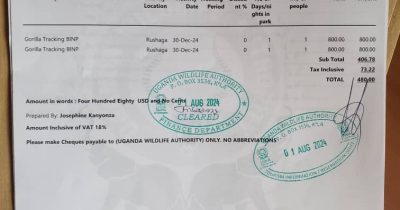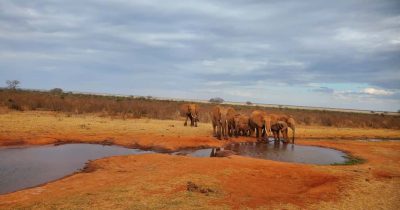Wildebeest Migration Map
Predicting the wildebeest migration map/pattern can be challenging if it is your first time visiting Kenya/Tanzania. Each year, over 2 million wildebeests, zebras, and other antelopes, such as elands and gazelles, embark on a long-distance migration crossing from Tanzania to the Mara Reserve. The wildebeest migration remains the iconic African experience, offering nature lovers a mesmerizing encounter of a lifetime.
The wildebeest migration map often takes a predictable clockwise path between the Serengeti and the Masai Mara ecosystem. These mammals undertake the long journey primarily to find palatable pasture and fresh water. The wildebeest migration map often depends on rainfall patterns in the Serengeti-Masai Mara ecosystem. Following each cycle helps you better understand the numerous events that unfold throughout the migration session. Below is a breakdown of the annual wildebeest migration map.
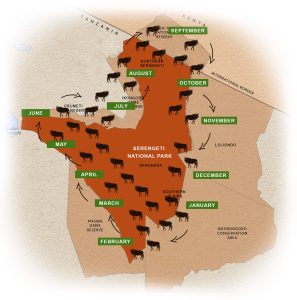
Migration Map in January
First, the Serengeti-Masai Mara ecosystems experience hot and humid summer conditions. On average, temperatures experienced vary from 15 to 28 degrees Celsius. The Great Migration is witnessed between Lobo and Naabi Hill. Around January, a large concentration of wildebeest herds is observed moving to find fresh grass for their calves. By January, 1000s of calves are born, and the adults can be available to provide the necessary protection. Visiting the Serengeti-Mara ecosystems in January also lets you encounter many predators as they converge in the breeding areas to hunt the vulnerable.
The largest concentration of wildebeest is spotted in the Mara and Grumeti Rivers. The conservancies bordering the Masai Mara Reserve have lower wildebeest and zebra populations.
The Migration Map in February
Visiting in February to witness the Great Migration offers an exceptional opportunity to observe the calving season in full swing. Large herds of wildebeests spread in the extensive plains of the Southern Serengeti and Ngorongoro, and can be seen giving birth. The herds spend about 2-3 weeks in these areas, while predators lurk patiently, targeting the weak.
The best locations to observe migration patterns in February include the Northern, Central, and Western regions of the Serengeti National Park, as well as the Masai Mara in the southern part of the park. A variety of wildlife can be spotted, including resident wildebeests, zebras, and other antelopes that remain in the private conservancies of the Mara Reserve.
Visit in March
Around March, wildebeest herds disperse across the Serengeti’s southern plains and the scenic Ndutu area. By this month, calves are typically strong enough to move. An effective way to observe these mammals in March is to take a hot-air balloon safari, flying above the vast plains of the Serengeti and Ndutu for excellent aerial views of different game.
The resident animals often dominate the Northern, Central, and Western sectors. In March, visitors have a combined tour in both the Serengeti and the Masai Mara. Beyond wildebeests and other antelopes, there is also a chance to watch other wildlife, including lions.
The Migration Map in April
The wildebeest herds start moving to the Northern regions and also spread into the Central and Western regions of the Serengeti National Park & River Grumeti. In April, most safari camps would have closed for maintenance, and this month also marks the start of the longest wet season. In April, the best place to see the resident animals is the Masai Mara Reserve in Kenya.
Migration Pattern in May
May is an exceptional month in its own right. The wildebeest converge in the Serengeti’s western corridor. The wildebeests often stagger around, while others begin to reach the Western corridor. Other herds can be far to the South and in some parts of the Central Serengeti. The herds in the western corridor often move into the private Grumeti Reserve, and by the end of May, they begin to form an immense profusion. In May, a hefty profusion of wildebeests is joined by the Grant’s & Thomson’s gazelles, plus zebras. The Seronera is usually the best place to spot these mammals.
June Migration Map
The Migration map in June is marked by large herds of wildebeest shifting to the western Serengeti, while others are in the Central Seronera. The wildebeests and zebras converge in large populations before they gather the momentum to cross the Grumeti River to connect to the North. June is also the wildebeest’s rutting/breeding month, with unique activities occurring. At the end of June, the migration reaches the Loita Migration.
Wildebeest Migration Map in July
In July, the wildebeest migration proceeds in a large concentration to assemble in the Grumeti Reserve and Ikorongo. Towards the end of July, we set out for the powerful Migration –the Mara River crossing. Watch at a close range how wildebeest struggle to cross the infested Nile crocodile River.
August
The main event in August is still the river crossing. Expect to watch a range of wildebeests together with many gazelles, zebras, and Kudus while they cross the river to the Masai Mara Reserve.
Migration Map in September
Most wildebeests that survive the dramatic River crossing can be spotted in the Northern section of the Serengeti, and others in the Masai Mara Reserve. The migration can extend depending on the rainfall pattern. The river crossing continues in August to early September.
October Migration Map
This offers a unique opportunity to observe large concentrations of zebras, wildebeests, and many other antelope species, including gazelles, Kudus, and others. October offers ideal conditions. It is in October when a section of the wildebeests start returning to the South via the Eastern end of the Serengeti and Loliondo.
November Migration Map
Short rains begin in November. An immense profusion of wildebeest herds begins to move faster towards the south, and short grass starts to grow. November is the best month to find wildebeests and zebras, as they are concentrated in the Northern Serengeti and moving towards the Seronera plains. The majority of these mammals are also confined to the Eastern border area adjacent to the Loliondo Game Reserve.
The Migration Map in December
Even in December, migration continues, and herds can be mainly observed heading south through the short grass of the Ndutu plains. They depend on fresh grasses with the calving season commencing once again. December marks the start of the cycle again.
Where to visit for the Great Migration
The Masai Mara and Serengeti National Park are excellent places to visit to witness the Great Migration. The Masai Mara is located in Kenya’s Narok County and is best known for its dramatic Mara River crossings. Serengeti National Park is located in Tanzania’s Northern Circuit, a 6-7-hour drive from Arusha town.
How to book a Wildebeest Migration safari
Want to witness the Great Migration but not sure how to book your tour? Contact Native Africa Tours to plan and secure the migration safari slot in Kenya or Tanzania. At Native Africa Tours, we offer flexible safaris where you can spice up your wildebeest migration with Big Five game drives. Or combine the migration tour with primate trekking, explicitly focusing on gorilla trekking in Uganda or Rwanda.
